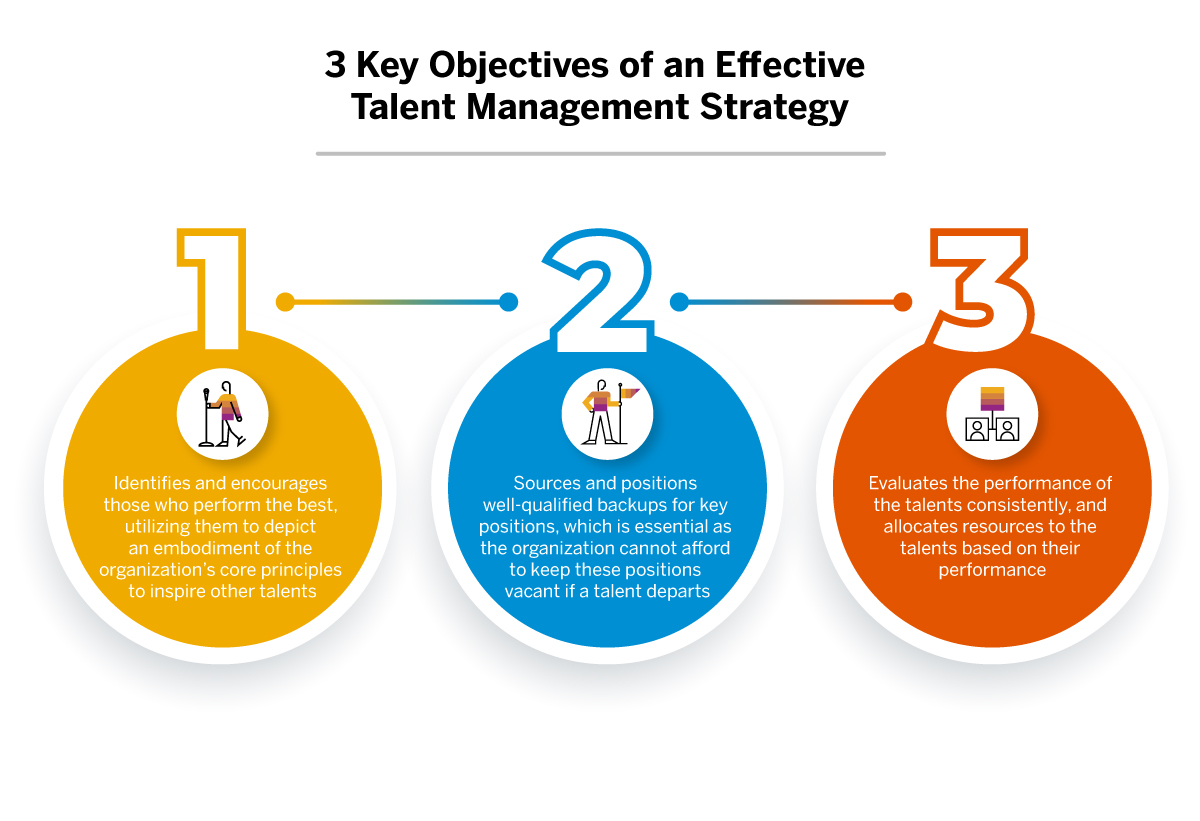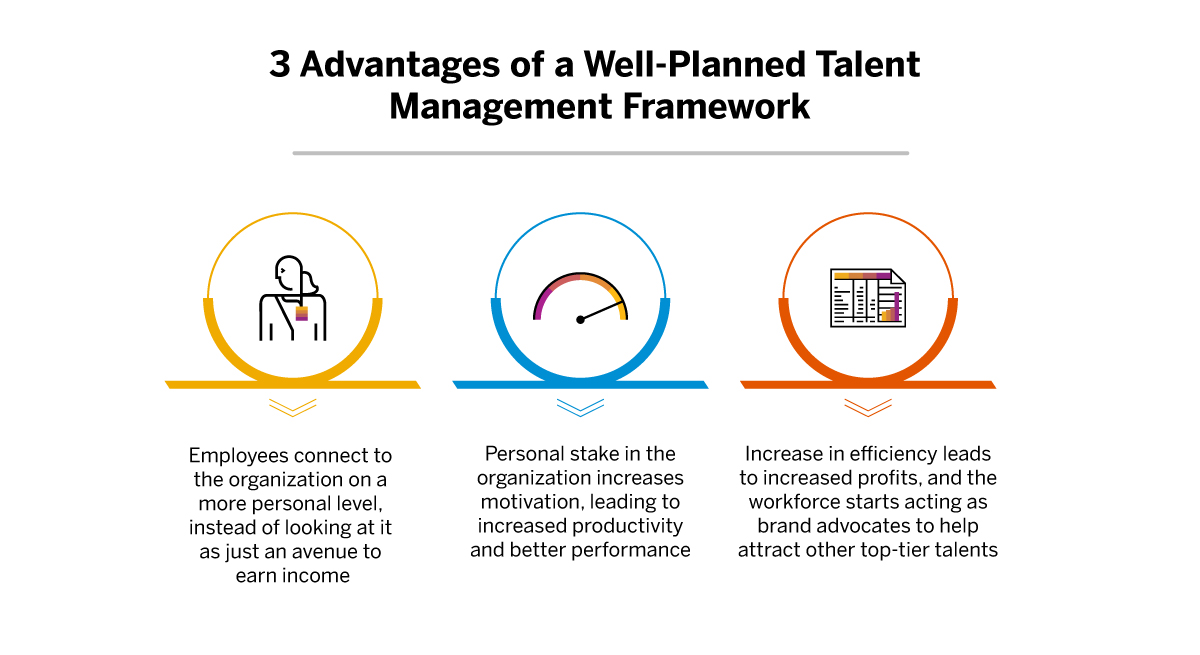Talent is a unique strategic resource for an organization, essential in gaining and sustaining a competitive advantage. However, finding and retaining competent human resources can be arduous. According to a Taylor & Francis report, more than 75% of CEOs face issues related to talent in their organizations. Other interesting findings from the report:

- Insufficient essential skills and capabilities among the employees pose a major threat to the growth prospects of these organizations.
- Finding, hiring and retaining the right people has been a continual challenge for the organizations. This has a direct bearing on how the organization sustains itself as well as on its performance.
Talent Management is a framework that helps improve organizational performance by identifying, developing and encouraging the best people. This involves helping the employees who are already working at the organization to flourish, as well as developing practices that attract the finest talent from outside. Talent management has emerged as one of the fastest-growing disciplines in the field of management. It also forms a major focus of developing successful human resource management systems because of the advantages that it offers the organization.
Factors Affecting Human Resources and Talent Management
Strategically managing human resources forms an essential part of an organization’s efforts to achieve efficient output and sustained success. Systematically identifying, managing and nurturing talent forms what is known as Strategic Human Resource Management (SHRM). Strategic HRM is influenced by external and internal factors.
-
External factors
The external factors that influence Strategic HRM include the market forces and demands, social, cultural and regulatory aspects of the market that the organization works in. This is the reason why some places and companies are able to develop better talent than others. As talent management strategies are directly linked to strategic HRM and eventually to the perception and success of an organization, it becomes crucial to develop better frameworks and systems for it. This is because an accomplished talent management system ensures a workforce working in the most optimum conditions.
-
Internal factors
The internal factors that influence human resources management in an organization are diverse and include organizational structure, as well as the administrative culture. They also include the nature of the services and the products that form the organization’s output, as well as the size, profit, returns, budgets and composition of the workforce. Mismanaging any of these can lead to losses. It can also dent the image of the company, leading to problems in future recruitments. Research has shown that all these internal factors are important while designing a talent management strategy. Such a strategy should therefore be knowledge and learning-oriented, inclusive and responsible towards its workforce. It should also allow its workforce to develop capabilities that help them adapt to the market’s dynamic requirements.
-
Creating a healthy administrative culture
A socially responsible HRD strategy with a prudent talent management framework can help the employees and the business improve ethical considerations. By educating employees about these ethics and norms, a talent management strategy not only helps in avoiding scandals and other issues, but also helps the organization to prioritize corporate social responsibility. This helps to develop a more positive work environment, resulting in increased productivity. It also helps to build a positive image for the organization.
Besides improving and enforcing ethics, a talent management framework also enables the company to nurture and incentivize creativity, open communications, effective knowledge management. By identifying and rewarding the right talent, a strongly positive effect is observed on attracting talent with the best capabilities, as well as retaining the talent that the organization already has.
-
Developing resilience
Human Resource Development Strategies (HRD), including Talent Management, have also been proven important in identifying the dimensions of an organization’s capacity for resilience. This is especially important under economic uncertainty and market fluctuations. Therefore, a robust HRD strategy can help build organizational resilience by bringing agility and adaptivity to the organization’s administrative structure. Besides the routine functions, a comprehensive HRD resilience can be attained through learning, training and developmental approaches. These can enable the employees to fully utilize their potential, allowing them to cope with the constantly shifting market trends and needs.
There are significant incentives that come with adopting effective talent management and human resource strategies. These are particularly useful to organizations with an international scope, as these organizations have to recruit talent from different geographies that differ in multiple aspects like institutional mechanisms, political developments, labor legislations, culture, local market factors as well as the positioning of the organization on the labor market.
Adopting an Effective Strategy for Human Resources
Managing the workforce is a critical responsibility of any organization. Besides, a proper talent management framework can help increase employee satisfaction, as well as enable the organization to recruit highly skilled people. Thus, an effective talent management strategy –
- Identifies and encourages those who perform the best. The best performers are motivated to keep working as the organization has much to gain through retaining them. A talent management strategy that considers the business context also utilizes them to depict an embodiment of the organization’s core principles to inspire other talents to perform better.
- Sources and positions well-qualified backups for key positions. This is essential as the organization cannot afford to keep these positions vacant for long if a talent departs.
- Allocates resources to the talents based on their performance, which is consistently evaluated. Good performance is rewarded and incentives are provided to inspire others. A talent management framework also identifies the performances of the talents.

Attaining all these objectives is based on some fundamental principles of a responsible talent management system. These consist of inclusivity, corporate responsibility, equity and equal employment opportunity. By foregrounding these principles in the talent management strategies, multilevel sustainable outcomes such as decent work, employee well-being and organizational well-being can be achieved.
This is followed by the realization by the employees that their needs are being taken care of. As employees take recognition of this, they tend to take part in the ownership of their organizations. This means that the employees-
- Connect to the organization on a more personal level, instead of looking at it as just an avenue to earn income.
- A personal stake in the organization increases motivation, leading to increased productivity and better performance. Well-managed employees put greater focus on the value that they can add to the overall output.
- As the organizational efficiency increases, so do its profits. An inspired workforce acts as brand advocates themselves and helps to attract other top-tier talents.

A well-planned talent management framework can therefore bring enormous dividends for the organization.
Through cloud-based talent management tools like SAP’s SuccessFactors, a business can enable its employees, managers, and HR professionals to manage the talents regardless of where or when they are working. SuccessFactors allows developing and adopting a comprehensive and data-driven talent management strategy. This strategy spans the entire employee lifecycle through different tools. These include Recruiting, Onboarding, Succession and Development, Performance & Goals software, Strategic compensation program, Learning Management System, Sales Performance Management (SPM),
These tools allow your organization to-
- Hire the best candidates through results-oriented recruiting practices and embedded engagement and automation.
- Bring your supporting systems, processes, and people into an intuitive digital experience, accessible from anywhere, on any device. This helps in conveniently setting up new hires coupled with improved engagement and retention throughout the employee lifecycle. You can also manage employee onboarding, cross-boarding, offboarding, internal transfers and rehiring programs through a single solution.
- Identify, develop, and retain your high-performing talent. It also allows your organization to engage employees with meaningful career development opportunities, close talent gaps, and nurture leaders. This can help your organization to develop the talent you need to achieve business goals, while providing visibility and planning capabilities to support future growth.
- Help employees expand their skills and advance their careers with ongoing employee development and leadership development through Talent reviews and calibration tools.
- Evaluate and recognize top talent, align your strategies and goals, and improve employee performance through ongoing coaching and feedback. This helps ensure that well-performing employees are valued and rewarded, which keeps the employees engaged and motivated.
- Align the needs of your employees, your business, and your budget with your business strategy through improved individual and business performance with personalized, timely rewards and recognition programs.
- Support employee training and reduce compliance risk with a modern learning experience.
- Deliver territory assignments and align sales quotas with agility, fairness, and transparency.
One of the most convenient features of the talent management programs is the ‘start anywhere, go anywhere’ approach they afford to the users. This approach allows an organization to implement the full suite or the various solutions in any order. For example, an organization can start at the most vulnerable point and adapt as the company’s needs grow. Or it can implement and execute this strategy from scratch and design the talent management process around this framework.
A well-integrated and holistic talent management system can help an organization attract, develop and retain talent, which remains one of the most significant challenges faced by enterprises worldwide.



